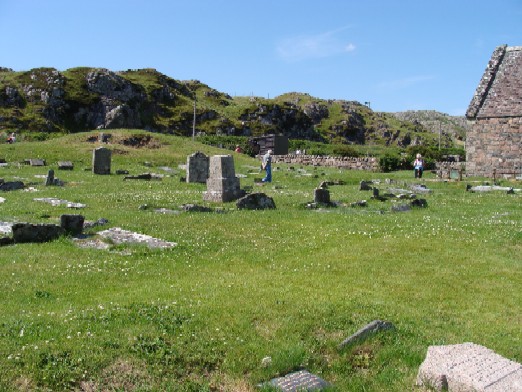The Isle of Iona
I’ve neglected my blog for two months. But something happened at the store today to remind me. I discovered a gentleman in a kilt browsing the history section.
I, of course, couldn’t resist engaging him in conversation. I ask him what clan. He said MacDonald. I told him we had spent a wonderful month in Scotland. He knew all the names of the places we had been. One of our favorite stops is a place I’ve only posted a few pictures from but not a full report. And it happens to be the burial place of Mr. MacDonald’s own ancestors.
I gave him my blog information, and now feel compelled to do this blog entry on his ancestral isle for him.
Iona was where Irish missionary St. Columba began his crusade in 563. In doing so, he made the island the first home of Christianity in northern Europe. Iona became an influential center for the spread of Christianity. It is where Scottish Kings were crowned. And it is said that this is where the famous Book of Kells was produced by monks in the late 700s. By extension, this cemetery is argued to be Christian Scotland’s most hallow ground. In this very abbey graveyard, 48 Scottish kings are said to have been buried.

Don’t let the photo fool you. Preservation concern is the reason why the cemetery looks so bedraggled. Most of the grave slabs were removed to an indoor museum to protect them from weathering.


The current abbey was built in the 1100s and expanded in the 1500s. It is beautiful in its simplicity. Walls made of rough hewn stone of uneven sizes, and an unplastered interior.


In the museum along with the grave slabs is the remains of St. John’s Cross. It was carved between 750AD and 800AD and erected just west of the shrine of St. Columba. The carvers were too ambitious and made the arms of the cross too long, causing it to collapse soon after it was put up. They tried to strengthen it by adding a supporting stone circle around the head. This circular ‘halo’ design was widely copied afterwards throughout Scotland and Ireland. The cross later broke again, and lay for centuries before it was brought into the museum and reinforced with plexiglass to represent its original look.


There is always a history lesson in these entries somewhere. Teach me more!
Great photos, Deborah! Such interesting info. I’m glad you ran into the kilted Mr. MacDonald!